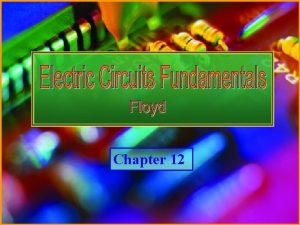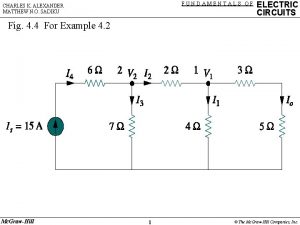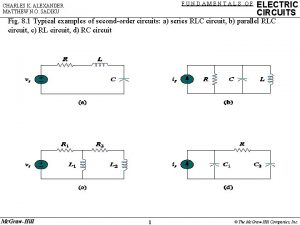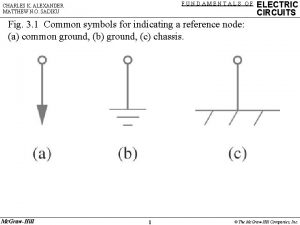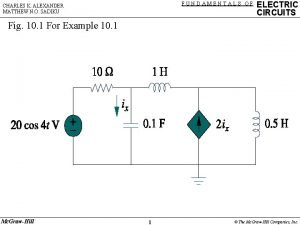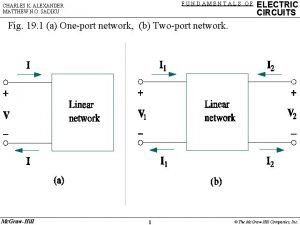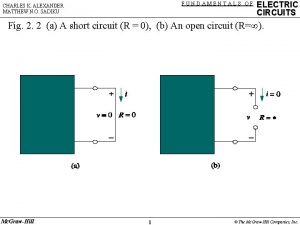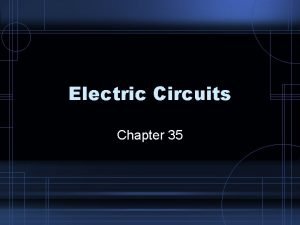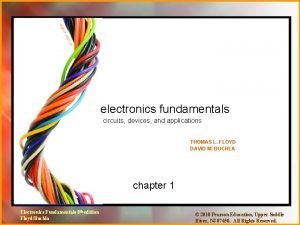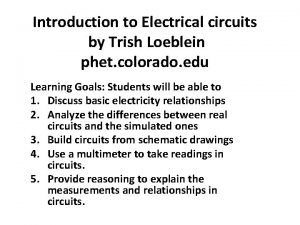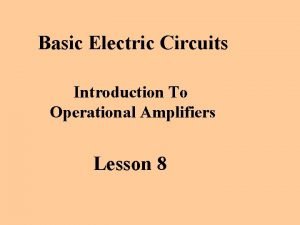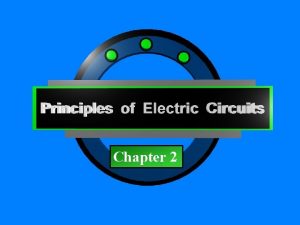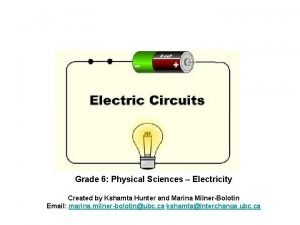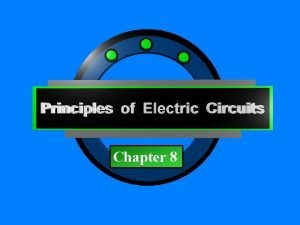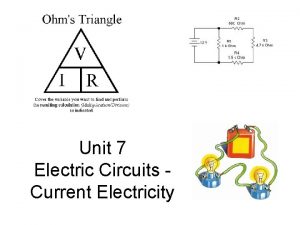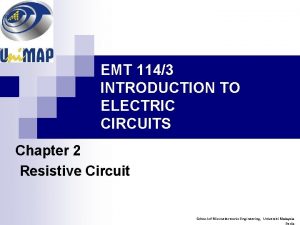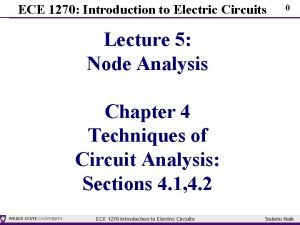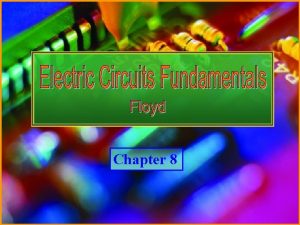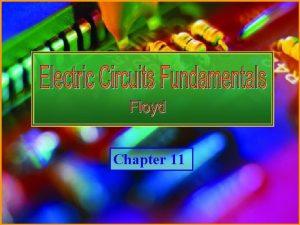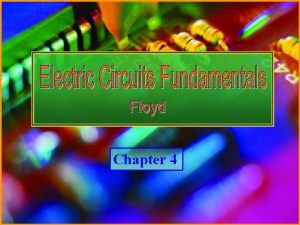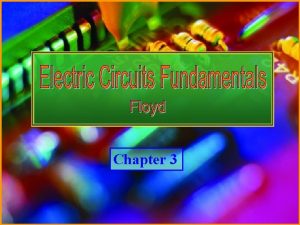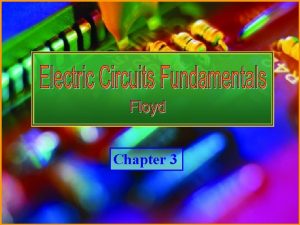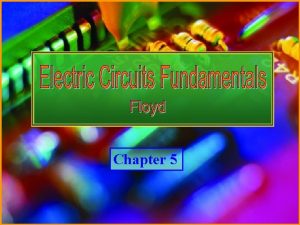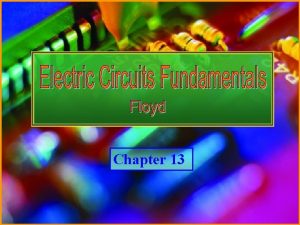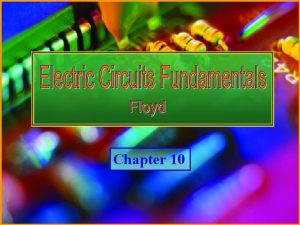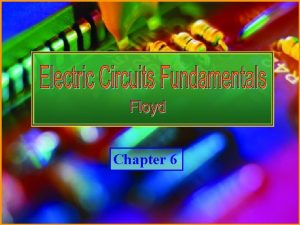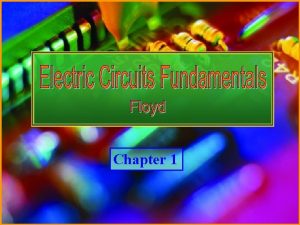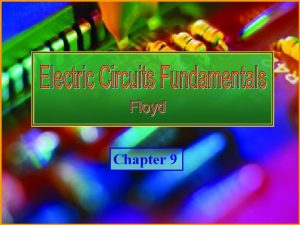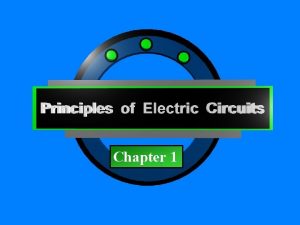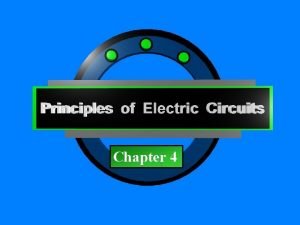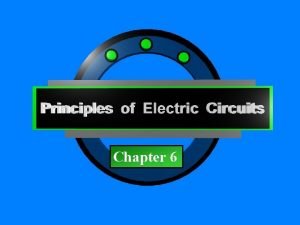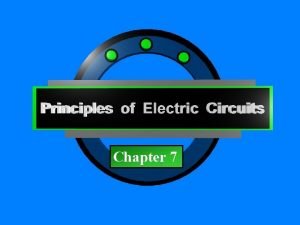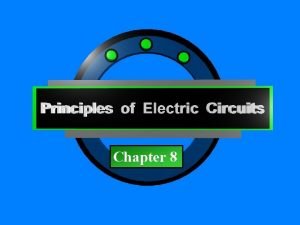Chapter 9 Electric Circuits Fundamentals Floyd Copyright 2007






































- Slides: 38

Chapter 9 Electric Circuits Fundamentals - Floyd © Copyright 2007 Prentice-Hall

Chapter 9 Summary The Basic Capacitors are one of the fundamental passive components. In its most basic form, it is composed of two conductive plates separated by an insulating dielectric. The ability to store charge is the definition of capacitance. Conductors Electric Circuits Fundamentals - Floyd Dielectric © Copyright 2007 Prentice-Hall

Chapter 9 Summary The Basic Capacitor The charging process… Initially Source Fully Charging charged removed uncharged A capacitor with stored charge can act as a temporary battery. Electric Circuits Fundamentals - Floyd © Copyright 2007 Prentice-Hall

Chapter 9 Capacitance is the ratio of charge to voltage Rearranging, the amount of charge on a capacitor is determined by the size of the capacitor (C) and the voltage (V). If a 22 m. F capacitor is connected to a 10 V source, the charge is 220 m. C Electric Circuits Fundamentals - Floyd © Copyright 2007 Prentice-Hall

Chapter 9 Capacitance An analogy: Imagine you store rubber bands in a bottle that is nearly full. You could store more rubber bands (like charge or Q) in a bigger bottle (capacitance or C) or if you push them in more (voltage or V). Thus, Electric Circuits Fundamentals - Floyd © Copyright 2007 Prentice-Hall

Chapter 9 Capacitance A capacitor stores energy in the form of an electric field that is established by the opposite charges on the two plates. The energy of a charged capacitor is given by the equation where W = the energy in joules C = the capacitance in farads V = the voltage in volts Electric Circuits Fundamentals - Floyd © Copyright 2007 Prentice-Hall

Chapter 9 Summary Capacitor types Mica capacitors are small with high working voltage. The working voltage is the voltage limit that cannot be exceeded. Electric Circuits Fundamentals - Floyd © Copyright 2007 Prentice-Hall

Chapter 9 Summary Capacitor types Ceramic disks are small nonpolarized capacitors They have relatively high capacitance due to high er. Electric Circuits Fundamentals - Floyd © Copyright 2007 Prentice-Hall

Chapter 9 Summary Capacitor types Plastic Film Plastic film capacitors are small and nonpolarized. They have relatively high capacitance due to larger plate area. Electric Circuits Fundamentals - Floyd © Copyright 2007 Prentice-Hall

Chapter 9 Summary Capacitor types Electrolytic (two types) Electrolytic capacitors have very high capacitance but they are not as precise as other types and tend to have more leakage current. Electrolytic types are polarized. Al electrolytic Ta electrolytic Symbol for any electrolytic capacitor Electric Circuits Fundamentals - Floyd © Copyright 2007 Prentice-Hall

Chapter 9 Summary Capacitor types Variable capacitors typically have small capacitance values and are usually adjusted manually. A solid-state device that is used as a variable capacitor is the varactor diode; it is adjusted with an electrical signal. Electric Circuits Fundamentals - Floyd © Copyright 2007 Prentice-Hall

Chapter 9 Capacitor labeling Capacitors use several labeling methods. Small capacitors values are frequently stamped on them such as. 001 or. 01, which have implied units of microfarads. Electrolytic capacitors have larger values, so are read as m. F. The unit is usually stamped as m. F, but some older ones may be shown as MF or MMF). Electric Circuits Fundamentals - Floyd © Copyright 2007 Prentice-Hall

Chapter 9 Capacitor labeling A label such as 103 or 104 is read as 10 x 103 (10, 000 p. F) or 10 x 104 (100, 000 p. F) respectively. (Third digit is the multiplier. ) When values are marked as 330 or 6800, the units are picofarads. What is the value of each capacitor? Both are 2200 p. F. Electric Circuits Fundamentals - Floyd © Copyright 2007 Prentice-Hall

Chapter 9 Summary Series capacitors When capacitors are connected in series, the total capacitance is smaller than the smallest one. The general equation for capacitors in series is The total capacitance of two capacitors is …or you can use the product-over-sum rule Electric Circuits Fundamentals - Floyd © Copyright 2007 Prentice-Hall

Chapter 9 Summary Series capacitors If a 0. 001 m. F capacitor is connected in series with an 800 p. F capacitor, the total capacitance is 444 p. F Electric Circuits Fundamentals - Floyd © Copyright 2007 Prentice-Hall

Chapter 9 Summary Parallel capacitors When capacitors are connected in parallel, the total capacitance is the sum of the individual capacitors. The general equation for capacitors in parallel is If a 0. 001 m. F capacitor is connected in parallel with an 800 p. F capacitor, the total capacitance is 1800 p. F Electric Circuits Fundamentals - Floyd © Copyright 2007 Prentice-Hall

Chapter 9 Summary The RC time constant When a capacitor is charged through a series resistor and dc source, the charging curve is exponential. Electric Circuits Fundamentals - Floyd © Copyright 2007 Prentice-Hall

Chapter 9 Summary The RC time constant When a capacitor is discharged through a resistor, the discharge curve is also an exponential. (Note that the current is negative. ) Electric Circuits Fundamentals - Floyd © Copyright 2007 Prentice-Hall

Chapter 9 Summary The RC time constant The same shape curves are seen if a square wave is used for the source. What is the shape of the current curve? VS VC VR The current has the same shape as VR. Electric Circuits Fundamentals - Floyd © Copyright 2007 Prentice-Hall

Chapter 9 Summary Universal exponential curves Specific values for current and voltage can be read from a universal curve. For an RC circuit, the time constant is Rising exponential Falling exponential Electric Circuits Fundamentals - Floyd © Copyright 2007 Prentice-Hall

Chapter 9 Summary Universal exponential curves The universal curves can be applied to general formulas for the voltage (or current) curves for RC circuits. The general voltage formula is v =VF + (Vi - VF)e-t/RC VF = final value of voltage Vi = initial value of voltage v = instantaneous value of voltage The final capacitor voltage is greater than the initial voltage when the capacitor is charging, or less that the initial voltage when it is discharging. Electric Circuits Fundamentals - Floyd © Copyright 2007 Prentice-Hall

Chapter 9 Summary Capacitive reactance is the opposition to ac by a capacitor. The equation for capacitive reactance is The reactance of a 0. 047 m. F capacitor when a frequency of 15 k. Hz is applied is 226 W Electric Circuits Fundamentals - Floyd © Copyright 2007 Prentice-Hall

Chapter 9 Summary Capacitive phase shift When a sine wave is applied to a capacitor, there is a phase shift between voltage and current such that current always leads the voltage by 90 o. Electric Circuits Fundamentals - Floyd © Copyright 2007 Prentice-Hall

Chapter 9 Summary Power in a capacitor Energy is stored by the capacitor during a portion of the ac cycle and returned to the source during another portion of the cycle. Voltage and current are always 90 o out of phase. For this reason, no true power is dissipated by a capacitor, because stored energy is returned to the circuit. The rate at which a capacitor stores or returns energy is called reactive power. The unit for reactive power is the VAR (volt-ampere reactive). Electric Circuits Fundamentals - Floyd © Copyright 2007 Prentice-Hall

Chapter 9 Summary Power supply filtering There are many applications for capacitors. One is in filters, such as the power supply filter shown here. Rectifier 60 Hz ac C Load resistance The filter smoothes the pulsating dc from the rectifier. Electric Circuits Fundamentals - Floyd © Copyright 2007 Prentice-Hall

Chapter 9 Selected Key Terms Capacitor An electrical device consisting of two conductive plates separated by an insulating material and possessing the property of capacitance. Dielectric The insulating material between the conductive plates of a capacitor. Farad The unit of capacitance. RC time A fixed time interval set by the R and C values, constant that determine the time response of a series RC circuit. It equals the product of the resistance and the capacitance. Electric Circuits Fundamentals - Floyd © Copyright 2007 Prentice-Hall

Chapter 9 Selected Key Terms Capacitive The opposition of a capacitor to sinusoidal reactance current. The unit is the ohm. Instantaneous The value of power in a circuit at a given power (p) instant of time. True power The power that is dissipated in a circuit (Ptrue) usually in the form of heat. Reactive The rate at which energy is alternately stored power (Pr ) and returned to the source by a capacitor. The unit is the VAR The unit of reactive power. (volt-ampere reactive) Electric Circuits Fundamentals - Floyd © Copyright 2007 Prentice-Hall

Chapter 9 Quiz 1. The capacitance of a capacitor will be larger if a. the spacing between the plates is increased. b. air replaces oil as the dielectric. c. the area of the plates is increased. d. all of the above. Electric Circuits Fundamentals - Floyd © Copyright 2007 Prentice-Hall

Chapter 9 Quiz 2. The major advantage of a mica capacitor over other types is a. they have the largest available capacitances. b. their voltage rating is very high c. they are polarized. d. all of the above. Electric Circuits Fundamentals - Floyd © Copyright 2007 Prentice-Hall

Chapter 9 Quiz 3. Electrolytic capacitors are useful in applications where a. a precise value of capacitance is required. b. low leakage current is required. c. large capacitance is required. d. all of the above. Electric Circuits Fundamentals - Floyd © Copyright 2007 Prentice-Hall

Chapter 9 Quiz 4. If a 0. 015 m. F capacitor is in series with a 6800 p. F capacitor, the total capacitance is a. 1568 p. F. b. 4678 p. F. c. 6815 p. F. d. 0. 022 m. F. Electric Circuits Fundamentals - Floyd © Copyright 2007 Prentice-Hall

Chapter 9 Quiz 5. Two capacitors that are initially uncharged are connected in series with a dc source. Compared to the larger capacitor, the smaller capacitor will have a. the same charge. b. more charge. c. less voltage. d. the same voltage. Electric Circuits Fundamentals - Floyd © Copyright 2007 Prentice-Hall

Chapter 9 Quiz 6. When a capacitor is connected through a resistor to a dc voltage source, the charge on the capacitor will reach 50% of its final charge in a. less than one time constant. b. exactly one time constant. c. greater than one time constant. d. answer depends on the amount of voltage. Electric Circuits Fundamentals - Floyd © Copyright 2007 Prentice-Hall

Chapter 9 Quiz 7. When a capacitor is connected through a series resistor and switch to a dc voltage source, the voltage across the resistor after the switch is closed has the shape of a. a straight line. b. a rising exponential. c. a falling exponential. d. none of the above. Electric Circuits Fundamentals - Floyd © Copyright 2007 Prentice-Hall

Chapter 9 Quiz 8. The capacitive reactance of a 100 m. F capacitor to 60 Hz is a. 6. 14 k. W. b. 265 W. c. 37. 7 W. d. 26. 5 W…… Electric Circuits Fundamentals - Floyd © Copyright 2007 Prentice-Hall

Chapter 9 Quiz 9. If an sine wave from a function generator is applied to a capacitor, the current will a. lag voltage by 90 o. b. lag voltage by 45 o. c. be in phase with the voltage. d. none of the above. Electric Circuits Fundamentals - Floyd © Copyright 2007 Prentice-Hall

Chapter 9 Quiz 10. A switched capacitor emulates a a. smaller capacitor. b. larger capacitor. c. battery. d. resistor. Electric Circuits Fundamentals - Floyd © Copyright 2007 Prentice-Hall

Chapter 9 Quiz Answers: 1. c 6. a 2. b 7. c 3. c 8. d 4. b 9. d 5. a 10. d Electric Circuits Fundamentals - Floyd © Copyright 2007 Prentice-Hall
 Electric circuits fundamentals floyd
Electric circuits fundamentals floyd Fundamentals of electric circuits chapter 4 solutions
Fundamentals of electric circuits chapter 4 solutions Fundamentals of electric circuits chapter 9 solutions
Fundamentals of electric circuits chapter 9 solutions Fundamentals of electric circuits chapter 7 solutions
Fundamentals of electric circuits chapter 7 solutions Sadiku
Sadiku Fundamentals of electric circuits
Fundamentals of electric circuits Alexander sadiku
Alexander sadiku Alexander
Alexander Fundamentals of electric
Fundamentals of electric Sadiku
Sadiku Ise fundamentals of electric circuits
Ise fundamentals of electric circuits Digital fundamentals floyd ppt
Digital fundamentals floyd ppt Digital fundamentals answers
Digital fundamentals answers Digital fundamentals 10th edition
Digital fundamentals 10th edition Electric current
Electric current Conceptual physics chapter 35
Conceptual physics chapter 35 Chapter 20 electric circuits
Chapter 20 electric circuits Chapter 35 electric circuits answers
Chapter 35 electric circuits answers Types of circuits and ohm's law worksheet answers
Types of circuits and ohm's law worksheet answers Chapter 35 electric circuits
Chapter 35 electric circuits Series parallel circuit current
Series parallel circuit current Electronics fundamentals circuits devices and applications
Electronics fundamentals circuits devices and applications Chapter 21 electric charge and electric field
Chapter 21 electric charge and electric field Chapter 21 electric charge and electric field
Chapter 21 electric charge and electric field Coloumb units
Coloumb units Units of a charge
Units of a charge Copyright 2007
Copyright 2007 Pearson
Pearson Phet electric circuits
Phet electric circuits Electric circuits equations
Electric circuits equations Electric circuits nilsson
Electric circuits nilsson Principle of electric circuit
Principle of electric circuit Three elements of a basic program for electrical safety are
Three elements of a basic program for electrical safety are Elec 202
Elec 202 Kshamta hunter
Kshamta hunter The circuit chapter 8 summary
The circuit chapter 8 summary Electric circuits
Electric circuits Introduction to electric circuits
Introduction to electric circuits Introduction to electric circuits
Introduction to electric circuits
